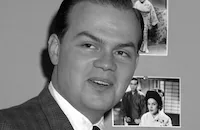Swordsman of Siena

Brief Synopsis
Cast & Crew
Etienne Périer
Stewart Granger
Sylva Koscina
Christine Kaufmann
Riccardo Garrone
Tullio Carminati
Film Details
Technical Specs

Synopsis
In the 16th century, Thomas Stanwood, an English adventurer and mercenary, arrives in the Italian city of Siena and joins the guard of Don Carlos, the city's despised, tyrannical Spanish governor. For political reasons, Don Carlos plans to wed Orietta Arconti, a member of one of Italy's most influential families; and he assigns Stanwood as her bodyguard. Violently opposed to the match is Orietta's younger sister, Serenella, who loathes the Spanish, disapproves of her sister's complicity, and sympathizes with The Ten, an underground force of Italian patriots. She learns that Don Carlos plans to force her to marry his cousin Hugo and attempts to flee the city, but she is killed by a guardsman. Stanwood then joins the underground and discovers that Orietta is the group's secret leader. For a number of years Hugo has contrived by foul play to win the annual Siena horserace, thereby obtaining the homage of the populace. Don Carlos arrests Paresi, who is to ride for The Ten in the race, and has him tortured to death. Stanwood then enters the race in his place. Don Carlos tries to have the Englishman murdered, but a stray crossbow bolt strikes a woman bystander, and the crowd riots. Hugo is unhorsed and trampled to death as he tries to kill Stanwood; and the Englishman is victorious. The Spaniards are driven from Siena by the elated populace, and Stanwood rides off to seek new adventures. However, Orietta sends her men to bring him back, and he returns a willing prisoner.

Cast

Stewart Granger
Sylva Koscina

Christine Kaufmann
Riccardo Garrone
Tullio Carminati
Alberto Lupo
Fausto Tozzi
Tom Felleghi
Carlo Rizzo
Claudio Gora

Marina Berti
Fanfulla
Giulio Marchetti
Ignazio Dolce
Crew
Gus Agosti
Jacques Bar
Alberto Boccianti
Sandro Continenza
Alec Coppel
Franco Delli Colli
Tonino Delli Colli
Kurt Doubravsky
Dominique Fabre
Franco Ferrara
Monique Isnardon
Robert Isnardon
Fay Kanin
Michael Kanin
Bianca Lattuada
Anthony Marshall
Mario Nascimbene
Carlo Rustichelli

Film Details
Technical Specs

Articles
Swordsman of Sienna -

Swordsman of Sienna -
Quotes
Trivia
Notes
Filmed in Siena and other locations in Tuscany. Opened in Paris in December 1962 as Le mercenaire; running time: 92 min; alternative French running time: 100 min. Italian titles: Lo spadaccino di Siena and Il mercenario. French and Italian sources credit Bandini as director; Continenza and Fabre as screenplay writers; and Rustichelli as composer of music. U. S. sources credit Périer as director; Michael Kanin, Fay Kanin, Coppel, and Marshall as writers; and Nascimbene with music.
















